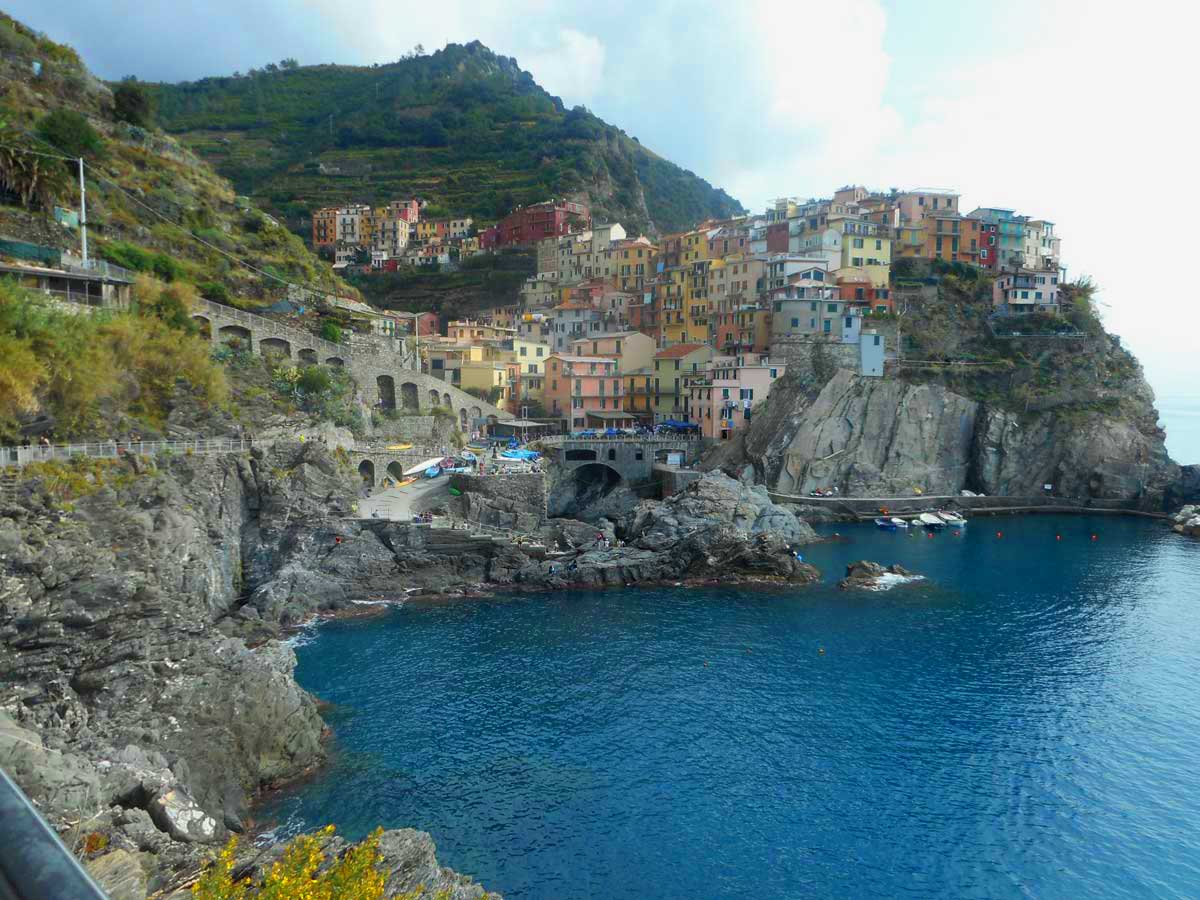About Genoa, Italy
Genoa (Genova) is a port city and capital of the Liguria region in northwest Italy. It’s known for its central role in maritime trade over many centuries. In the old town stands the Romanesque Cathedral of San Lorenzo, with its black-and-white-striped facade and frescoed interior. Narrow lanes open onto monumental squares like Piazza de Ferrari, site of an iconic bronze fountain and the Teatro Carlo Felice opera house.
Venice, Rome, Milan, and Florence are of course the most known and admired towns in Italy. When moving to north-western Italy (Milan, Turin) it is nevertheless absolutely worth staying for a couple of days or a weekend in Genoa. The city is a good base to explore the Italian Riviera and world famous places like Portofino and the Cinque Terre.
Genoa can be easy travelled to by train from Milan, Turin, Rome, Tuscany (Pisa, Livorno and Florence (changing train in Pisa or Viareggio)) and France (There is a direct train connecting with Nice and Marseille). There are two main train stations in Genoa, Brignole and Principe. Brignole serves most local routes and provides access to many bus lines. Principe serves local as well as long distance trains and many trains from Milan and beyond will only stop at this station.
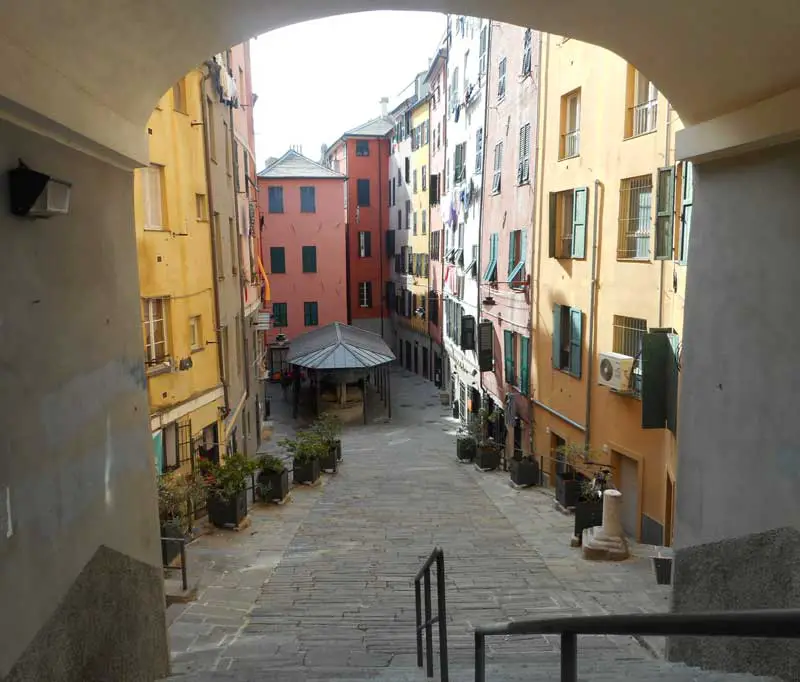
Plan and Book:



Overview
Genoa is a sort of decayed glorious port town, whose decay, however, is what makes it so interesting and pretty. The facades of grand palaces are hidden in scruffy, yet enticing alleyways, and there are really curious treats for anyone in virtually every alley. The city is your “typical” Italian one – quite sunny (during summer), with Mediterranean-looking houses topped by grey slate roofs, filled to the brim with outdoor cafes and bars, with lots of tiny and quirky alleyways, elegant designer shops, and restaurants. Today, also, the old port has been renovated, and currently contains some funky avant-garde modern architecture, a delightful marina, and several seaside bars and shops.
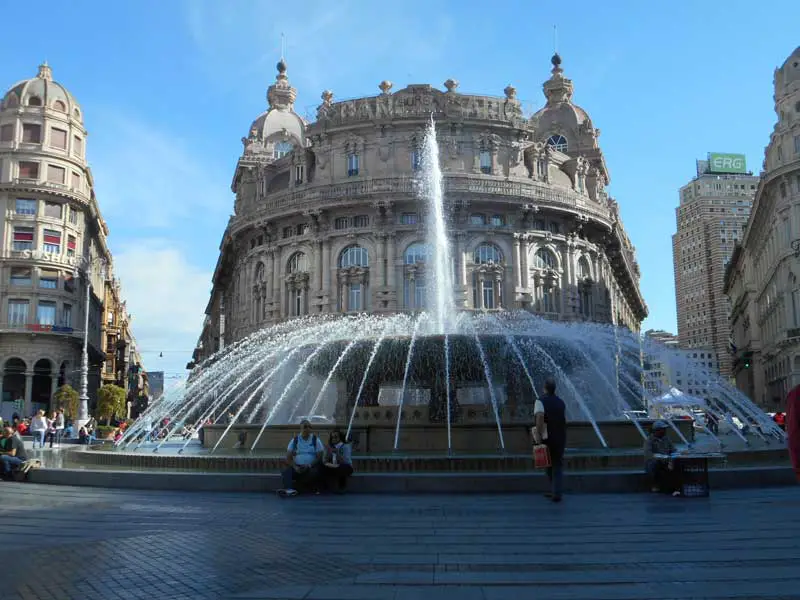
Genoa today, as a tourist attraction, is often shadowed by cities such as Rome or Venice, even though it has a long history as a rich and powerful trade centre. However, with its multitude of hidden gems behind cozy alleyways, excellent cuisine (notably fish and seafood), renovated old port, beautiful sights (including one of Europe’s biggest aquariums), and its position as the European Capital of Culture in 2004 have made the birthplace of explorer Christopher Columbus an enticing place which is gradually becoming more included as a tourist destination. With pastel-coloured terracotta-roofed houses, artistic churches, lovely seaside villas, and also several luxurious boutiques, Genoa is a must see if you want to experience the “quintessential” Italy.
Pesto sauce originates from the city of Genoa. It is used in many dishes, including pastas and pizzas – you can always order from the huge variety of pastas and pizzas available here, but trying the one which is based on Pesto is a must to experience the traditional Genovese cuisine. Another must try from the Genovese or Ligurian cuisine is the focaccia, which essentially is a flat oven-baked Italian bread, which may be topped with onions, herbs, or other foodstuffs. They are quite tasty and often cheaper than pizzas. There are many ‘Focaccerias’ scattered throughout Genova and its surroundings. These are basically take away places, and easy on the wallet, too. In many of the focaccerias, you will find improvised varieties of focaccias, but usually, the best tasting ones come with only tomatoes or onions and a bit of olive oil. The original “focaccia” is simply topped with olive oil and salt.
Don’t miss to try the farinata, a thin crusty pie made with chick-peas flour, water, salt, and olive oil.
When walking, you should not expect motorists (especially scooters and bikers) to be particularly disciplined. At unsignalized crosswalks, you might need to insist on your right of way by just starting to cross the road (with caution!), as Italian pedestrians normally do, rather than waiting for motorists to stop. If a car, van or truck has stopped to let you cross, be very careful and always assume there might be a scooter passing that vehicle at high speed without seeing you.
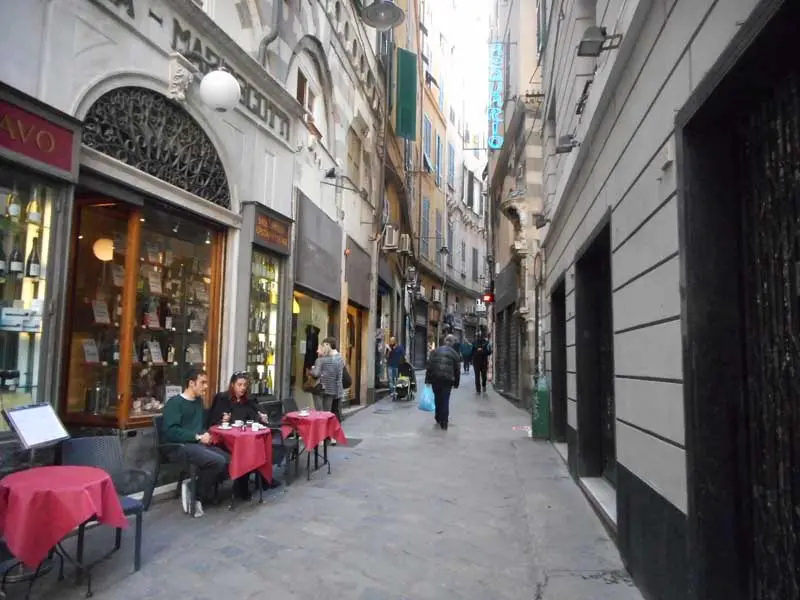
Attractions and Activities
There are plenty of things to do in Genoa. A lot of young kids spend their time playing with their friends in public pools and share ice-creams in the summer time. There are a lot of paintings in the town and on the brick floors which a lot of people admire. Fishing for catfish is also a hobby most people have.
All attractions within the centre are in walking distance or well served by public transportation, therefore a car is of no use at all. If you still decide to drive into the city, don’t bet on available street parking (there are street parking fees anyway) go directly to a parking garage and hope not all of them are full. If you think of driving to the beach on a sunny weekend day within Genoa or in another town along the coast, forget it. Finding a parking spot in walking distance to your beach is an once-in-a-lifetime event. Use public transit instead.
Genoa is known to have Europe’s biggest historical centre. This is the heart of the old city and it’s easy to spend hours just wandering around and taking the sights, sounds and smells. It’s made up of an incredible amount of tiny streets and alleys called Caruggi. Walking through it will plump you right back in ancient times when Genoa was the most important harbor of the Mediterranean sea. The city is generally safe, but caution is to be applied, especially at night time and in the more quiet zones toward Piazza Principe and the old harbour, due to presence of small criminality.
Downtown, for those who want luxury boutique browsing, you can find some world class fashion-related shopping along Via XX Settembre, starting from Piazza Ferrari. There are a lot of small, picturesque and tourism-related shops in the centre. These are mainly in the central squares and the small alleyways. You can find souvenir stalls, kiosks selling books and snacks, sailor-themed stalls, traditional flea markets, modern and antique furniture dealers, little bookstores and tiny art galleries. There is a large shopping centre called Fiumara located near Genova Sampierdarena train station. To reach Fiumara, take a local train to Genova Sampierdarena station and exit the station. Turn left and go under a bridge, near which there is a sign to the left for Fiumara. The shopping center is visible from the other side of the bridge and is about 10 minutes walk. The mall can also be reached by car or bus routes 1, 2, 4 and 22.
Virtually all beaches in Genoa and surroundings are made of cobbles, rocks and cliffs. The sea floor is normally very steep and you won’t be able to touch the ground just some meters away from the shore, hence beware if your swimming skills are not good. When bathing, be extremely cautious as stones under water are mostly covered with vegetation and very slippery. Avoid bathing at all if the sea is not calm: waves that may seem innocent from the shore might be strong enough to turn getting out of the sea into a quite dangerous and scary undertaking, running the risk of being smashed into the shore or into a rock (that you perhaps don’t see because it’s under water). There is normally no lifeguard service on free public beaches.
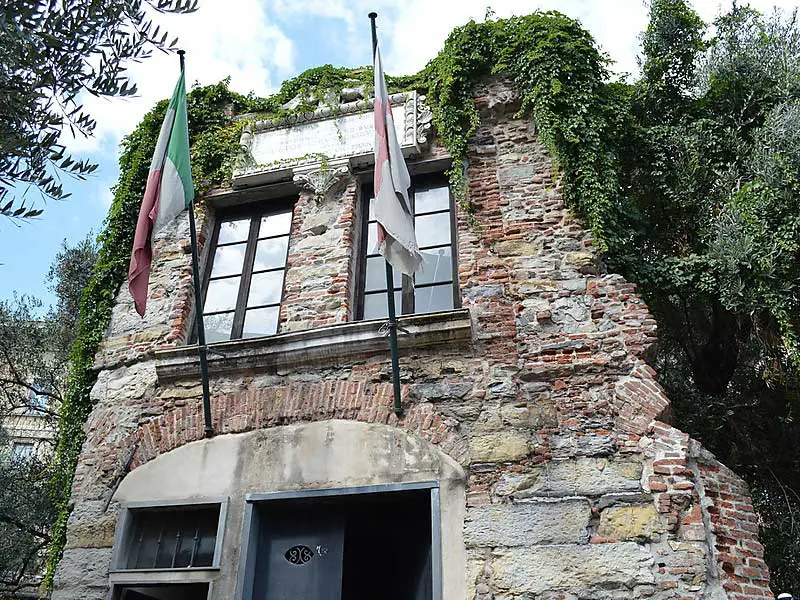
A widely promoted historical site is the house of Chirstopher Columbus just outside the Porta Soprana city gates. Many who go there leave feeling somewhat conned, as no one knows exactly where Columbus was born, raised and lived. It was somewhere in the vicinity, and may well have been this house, but even if was, this is only a reconstruction built from ruins of the house. Today it serves as a museum of his life, and a good one at that. Christopher Columbus (1451-1506), an Italian explorer, navigator, colonizer, and citizen of the Republic of Genoa, completed four voyages across the Atlantic Ocean. Those voyages and his efforts to establish permanent settlements on the island of Hispaniola initiated the European colonization of the New World. During his first voyage in 1492, he reached the New World instead of arriving at Japan as he had intended, landing on an island in the Bahamas archipelago that he named “San Salvador”.
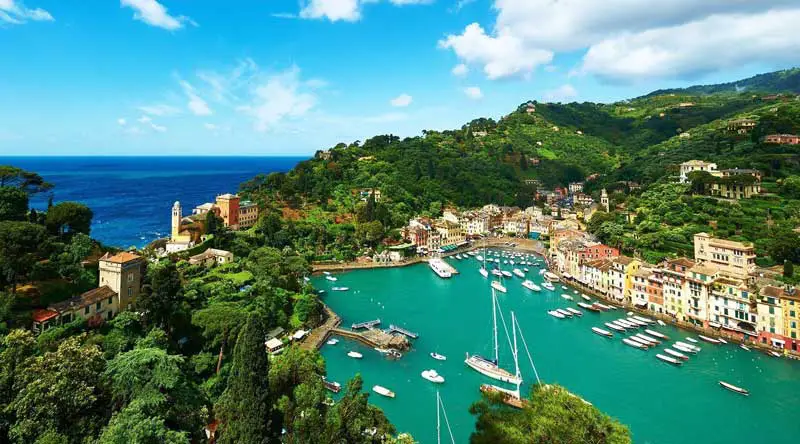
Portofino
Anyone who visits Genoa but doesn’t squeeze in a visit to Portofino is short-changing themselves. Portofino is an Italian fishing village and vacation resort famous for its picturesque harbour and historical association with celebrity and artistic visitors. Set on the Italian Riviera, the town is clustered around its small harbour, and is known for the colourfully painted buildings that line the shore.
Ever since Pliny the Elder founded Portofino, this wonderful corner of the Mediterraean has been a magnet for leisure seekers. Pliny, a Roman author, naturalist, and natural philosopher, as well as naval and army commander of the early Roman Empire, named it Portus Delphini, or Port of the Dolphin, because of the large number of dolphins that inhabited the Tigullian Gulf. In the late 19th century, first British, then other Northern European aristocratic tourists began to visit Portofino, which they reached by horse and cart from Santa Margherita Ligure. Aubrey Herbert and Elizabeth von Arnim were amongst the more famous English people to make the area fashionable. Eventually more expatriates built expensive vacation houses, and by 1950 tourism had supplanted fishing as the town’s chief industry, the waterfront became a continuous ring of restaurants and cafes, and the focal point of this playground for the rich and famous.
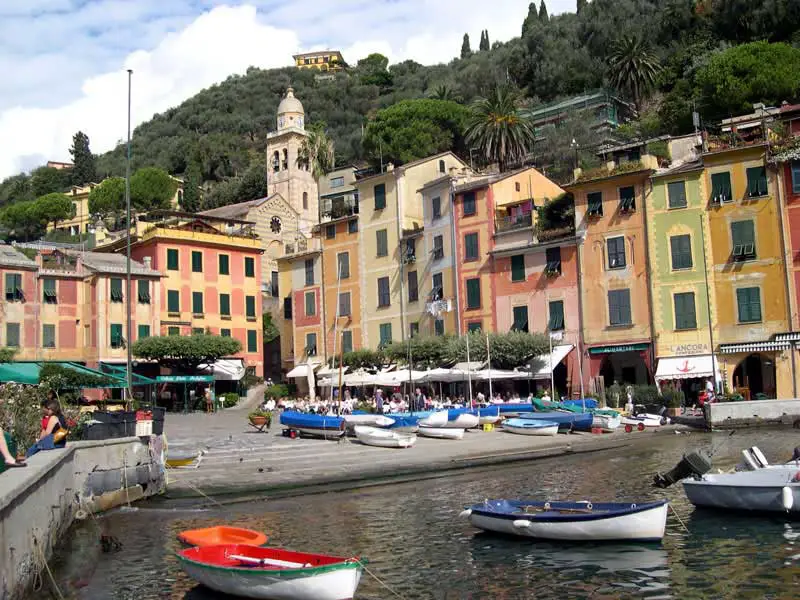
The nearest railway station, S. Margherita Ligure-Portofino, is about 5 km away in Santa Margherita Ligure. A train from Genoa takes around 45 minutes. Catch bus 82 from outside the S. Margherita Ligure-Portofino station to Portofino. Purchase tickets before boarding from the station cafe. 3 euro one way, 5 euro return. Much more relaxing, however, is a pleasant ferry ride along the coast. In summer, there is one direct daily departure in each direction from Genoa. It is scheduled to allow a pleasant day trip. Otherwise, the region’s well-developed ferry network provides various connections that could get you to Portofino with a change of boats in such as Santa Margherita Ligure.

